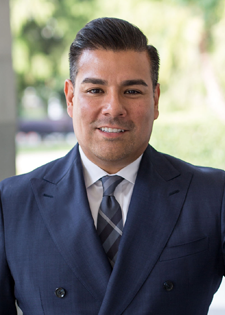The government of California is the governmental structure of the U.S. state of California as established by the California Constitution. California uses the separation of powers system to structure its government. It is composed of three branches: the executive, consisting of the governor of California and the other constitutionally elected and appointed officers and offices; the legislative, consisting of the California State Legislature, which includes the Assembly and the Senate; and the judicial, consisting of the Supreme Court of California and lower courts. There is also local government, consisting of counties, cities, special districts, and school districts, as well as government entities and offices that operate independently on a constitutional, statutory, or common law basis. The state also allows direct participation of the electorate by initiative, referendum, recall and ratification.

The United States Department of the Interior (DOI) is an executive department of the U.S. federal government responsible for the management and conservation of most federal lands and natural resources. It also administers programs relating to Native Americans, Alaska Natives, Native Hawaiians, territorial affairs, and insular areas of the United States, as well as programs related to historic preservation. About 75% of federal public land is managed by the department, with most of the remainder managed by the Department of Agriculture's Forest Service. The department was created on March 3, 1849. It is headquartered at the Main Interior Building, located at 1849 C Street NW in Washington, D.C.
The United States order of precedence is an advisory document maintained by the Ceremonials Division of the Office of the Chief of Protocol of the United States which lists the ceremonial order, or relative preeminence, for domestic and foreign government officials at diplomatic, ceremonial, and social events within the United States and abroad. The list is used to mitigate miscommunication and embarrassment in diplomacy, and offer a distinct and concrete spectrum of preeminence for ceremonies. Often the document is used to advise diplomatic and ceremonial event planners on seating charts and order of introduction. Former presidents, vice presidents, first ladies, second ladies, and secretaries of state and retired Supreme Court justices are also included in the list.

The California executive branch consists of elected officers and other offices and officers. The elected executive officers are:
The California Department of Conservation is a department within the government of California, belonging to the California Natural Resources Agency. With a team of scientists, engineers, environmental experts, and other specialists, the Department of Conservation administers a variety of programs vital to California's public safety, environment and economy. The department's mission is to manage California's working lands. It regulates oil, natural gas and geothermal wells; studies and maps earthquakes and other geologic phenomena; maps and classifies areas containing mineral deposits; ensures reclamation of land used for mining; and administers agricultural and open-space land conservation programs. A division within the department dedicated to encouraging beverage container recycling has been moved into the newly created Department of Resources Recovery and Recycling (CalRecycle). Despite the similar name, the Department of Conservation should not be confused with the California Conservation Corps, another department within the Natural Resources Agency, which provides work experience for young adults. The Department of Conservation often collaborates with its federal equivalents, such as the U.S. Geological Survey.

The California Natural Resources Agency (CNRA) is a state cabinet-level agency in the government of California. The institution and jurisdiction of the Natural Resources Agency is provided for in California Government Code sections 12800 and 12805, et seq. The agency has six departments, 10 conservancies, 17 boards and commissions, three councils, and one urban park in Los Angeles that consists of two museums, the California Science Center and the California African American museum. Through its 25 departments, conservancies and commissions, the Natural Resources Agency is responsible for protecting prehistory history, natural landscapes and cultural sites, monitoring and stewarding state lands and waterways, and regulating fish and game use, as well as private lands and the intersection with federal lands and waters.
The California Department of Social Services (CDSS) is a California state agency for many of the programs defined as part of the social safety net in the United States, and is within the auspices of the California Health and Human Services Agency. Federal and State funds for adoptions, the largest SNAP program in the country, CalWORKs program, foster care, aid for people with disabilities, family crisis counseling, subsistence payments to poor families with children, child welfare services and many other efforts are distributed through this department.
The Pennsylvania Department of Environmental Protection (DEP) is the agency in the U.S. state of Pennsylvania responsible for protecting and preserving the land, air, water, and public health through enforcement of the state's environmental laws. It was created by Act 18 of 1995, which split the Department of Environmental Resources into the Department of Environmental Protection and the Department of Conservation and Natural Resources. Its current secretary is Jess Shirley.
The California Health and Human Services Agency (CHHS) is the state agency tasked with administration and oversight of "state and federal programs for health care, social services, public assistance and rehabilitation" in the U.S. state of California. The agency is headed by the Secretary of the California Health and Human Services Agency, with headquarters in Sacramento. Many of the laws in the California Health and Safety Codes are enforced by it.
The California Department of Resources Recycling and Recovery is a branch of the California Environmental Protection Agency that oversees the state's waste management, recycling, and waste reduction programs. CalRecycle was established in 2010 to replace the California Integrated Waste Management Board. It is known for administering the California Redemption Value (CRV) program, among other responsibilities.

The Office of Environmental Health Hazard Assessment, commonly referred to as OEHHA, is a specialized department within the cabinet-level California Environmental Protection Agency (CalEPA) with responsibility for evaluating health risks from environmental chemical contaminants.

The California State Water Resources Control Board (SWRCB) is one of six branches of the California Environmental Protection Agency.
Certified Unified Program Agencies, or CUPAs, are local agencies that are certified by the Secretary of the California Environmental Protection Agency (CalEPA) to implement the CalEPA Unified Program elements in the CUPA's jurisdiction. The CalEPA Unified Program consolidates, coordinates, and makes consistent the administrative requirements, permits, inspections, and enforcement activities of six environmental and emergency response programs in California. These six programs are:

Robert Perciasepe is an American former government official who currently serves as a senior adviser to McKinsey and Company and the nonprofit Center for Climate and Energy Solutions, following his role as President of the organization. He served as the Deputy Administrator and Acting Administrator of the U.S. Environmental Protection Agency during the administration of Barack Obama.

The California Department of Financial Protection and Innovation regulates a variety of financial services, businesses, products, and professionals. The department operates under the California Business, Consumer Services and Housing Agency.

The California State Transportation Agency (CalSTA) is a state cabinet-level agency with the government of California. The agency is responsible for transportation-related departments within the state. The agency was created under governor Jerry Brown in 2013 after the previous Business, Transportation and Housing Agency's portfolio underwent reorganization.

The Government Operations Agency (CalGovOps) is the California government agency responsible for administering state operations including procurement, real estate, information technology, and human resources. Amy Tong was appointed Secretary of Government Operations by Governor Gavin Newsom in March of 2022. Previously, the role was held by Secretary Yolanda Richardson and Secretary Marybel Batjer, who was appointed as the inaugural agency secretary in June 2013 by then-Governor Jerry Brown.

Mary Dolores Nichols is an American attorney and government official who has been the chairwoman of the California Air Resources Board (CARB) since 2007. She also held that post between 1979 and 1983. From 1999 to 2003, she served as secretary of the California Natural Resources Agency in the cabinet of then-Governor Gray Davis. Due to her efforts to combat global warming, she has been dubbed "the Queen of Green", and described as "the most influential environmental regulator in history."
Matthew Rodriquez is an American attorney who served as the acting Attorney General of California from March 18, 2021, when Attorney General Xavier Becerra became United States Secretary of Health and Human Services, until April 23, 2021, when Assemblyman Rob Bonta became Attorney General.











